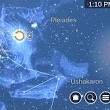The Magic of Star Charts: Navigating the Celestial Symphony
Star charts, also known as star maps or celestial maps, have been guiding humanity through the vast expanse of the night sky for centuries. These intricate diagrams serve as windows to the heavens, offering a glimpse into the cosmic ballet of stars, planets, and constellations that adorn our universe.
From ancient civilisations to modern astronomers, star charts have played a crucial role in understanding and navigating the mysteries of space. By plotting the positions of celestial bodies against a backdrop of imaginary lines and figures, these maps provide a roadmap for stargazers to identify and locate key astronomical objects.
One of the most famous star charts is the Messier Catalogue, compiled by French astronomer Charles Messier in the 18th century. This collection of over 100 deep-sky objects, including galaxies, nebulae, and star clusters, has become a valuable tool for amateur astronomers seeking to explore the wonders of the night sky.
Today, with advancements in technology, star charts have evolved from static paper maps to dynamic digital tools. Astronomy enthusiasts can now access interactive sky maps on their smartphones or computers, allowing them to track celestial events in real-time and enhance their stargazing experience.
Whether you’re an amateur astronomer or simply a lover of the night sky, exploring the world of star charts can open up a universe of wonder and discovery. So next time you gaze up at the twinkling stars above, remember that hidden within their patterns lies a celestial symphony waiting to be unravelled with the help of a trusty star chart.
Understanding Star Charts: Common Questions and Answers
- 1. What is a star chart and how is it used?
- 2. How can I read and interpret a star chart?
- 3. What are the different types of star charts available?
- 4. Are there online resources or apps for accessing interactive star charts?
- 5. How do astronomers create and update star charts?
- 6. Can star charts help me locate specific constellations or planets in the night sky?
1. What is a star chart and how is it used?
A star chart, also known as a star map or celestial map, is a graphical representation of the night sky that displays the positions of stars, planets, and other celestial objects. It serves as a visual guide for astronomers and stargazers to navigate and identify key astronomical features in the sky. By referencing a star chart, individuals can locate specific constellations, track the movement of planets, and observe celestial events such as meteor showers or eclipses. Whether in traditional paper form or as interactive digital software, star charts provide a valuable tool for exploring the wonders of the universe and enhancing one’s understanding of the cosmos above.
2. How can I read and interpret a star chart?
Understanding how to read and interpret a star chart is essential for navigating the night sky with confidence and clarity. To decode a star chart, start by familiarising yourself with the cardinal directions and identifying key reference points such as Polaris, the North Star. Next, learn to recognise major constellations and their positions relative to each other. Pay attention to the scale of the chart and understand how it represents the celestial sphere above you. By practising regularly and using tools like planispheres or mobile apps, you can enhance your ability to read star charts effectively and unlock the secrets of the cosmos above.
3. What are the different types of star charts available?
There are several types of star charts available to aid in navigating the night sky. Beginners often start with planispheres, which are simple handheld devices that display a map of the sky visible at a specific time and date. Constellation maps focus on outlining the patterns created by stars, making it easier to identify different groupings in the sky. Sky atlases provide detailed maps of the entire celestial sphere, offering a comprehensive view of stars, galaxies, and other celestial objects. Additionally, digital star charts have become popular, allowing users to access interactive maps on electronic devices for a more dynamic stargazing experience. Each type of star chart serves a unique purpose in helping enthusiasts explore and appreciate the wonders of the cosmos above.
4. Are there online resources or apps for accessing interactive star charts?
In the digital age, accessing interactive star charts has never been easier thanks to a plethora of online resources and apps dedicated to astronomy. Whether you’re a novice stargazer or a seasoned astronomer, these tools offer a wealth of information at your fingertips, allowing you to explore the night sky in real-time, identify celestial objects, and track upcoming astronomical events with ease. From user-friendly mobile apps to comprehensive websites, there are plenty of options available for those looking to enhance their stargazing experience using interactive star charts.
5. How do astronomers create and update star charts?
Astronomers create and update star charts through a combination of observation, data analysis, and technological tools. Initially, astronomers use telescopes and other instruments to observe the positions of stars, planets, and other celestial objects in the night sky. They then record this data and process it using advanced software to accurately plot the locations of these objects on a chart. To ensure accuracy and relevance, astronomers regularly update star charts by incorporating new observations, discoveries, and astronomical data collected from ground-based observatories and space telescopes. This continuous process of observation and analysis allows astronomers to create detailed and up-to-date star charts that serve as essential guides for navigating the cosmos.
6. Can star charts help me locate specific constellations or planets in the night sky?
Certainly! Star charts are invaluable tools for locating specific constellations or planets in the night sky. By referencing a star chart that accurately depicts the positions of celestial objects at a given time and location, stargazers can easily identify and track their desired targets among the myriad of stars above. Whether you’re seeking out the majestic Orion constellation or hoping to catch a glimpse of the elusive planet Mars, a well-prepared star chart can serve as your guiding light in navigating the celestial wonders that adorn our universe.



